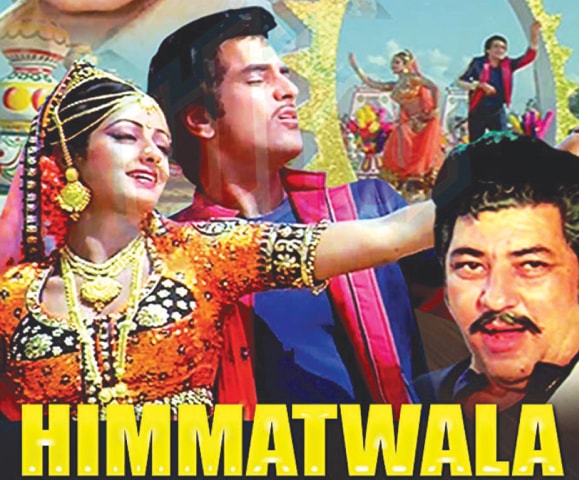Omair Alavi|Published February 17, 2019
Publicity poster for Himmatwala, the 1983 superhit Hindi film that made Sridevi a Bollywood star
Sridevi was no ordinary film actress — she was running around from set to set since she was four years old and by the time she called it quits, in the late 1990s, she had become an iconic figure in Bollywood. But who was the real Sridevi? Was it the girl who couldn’t say no to her mother or the woman who became the first-choice actress of all mainstream directors? Lalita Iyer’s Sridevi: Queen of Hearts traces the life of Miss Hawa Hawaii from her early days as a child actress to her final days after Mom.
In a move that comes across as quite odd for a biography, the author charts the life of the actress through the prism of her own relationship with her own mother — the very first chapter is titled ‘How I Met My Mother’. Iyer’s mother — who might as well have been credited as co-author considering how much of the content is devoted to her thoughts and opinions — was a great fan of Sridevi. Iyer, a journalist, author and blogger, was not very interested in the actress while growing up. However, when she decided to write the book, she watched all of Sridevi’s films again and that was when she reconnected with her own mother as the two bonded over the superstar of the 1980s.
The actual biographical aspect of the book begins with Sridevi’s life as a child star; she was pushed into the Tamil film industry by her mother, Rajeswari Yanger, who wanted to be an actress herself, but having failed at that, lived her dreams through her daughter. From Tamil films Sridevi moved to the Telegu and Malayalam industries and, in no time, became the must-have-in-your-film when she transformed from a shy girl into a voluptuous woman — before she turned 11 years old. At an age when other girls were receiving basic education in school, Sridevi was being made to do sensual scenes despite being too young to completely understand what romance meant.
A fan’s exploration of the life and career of the iconic cinema superstar
Written as it is from a fan’s point of view, the trajectory of the actress’s life is punctuated with observations from the mother-author/daughter duo which sometimes makes the book seem unnecessarily opinionated. For instance, when Iyer writes about Sridevi’s move from the south to mainstream Hindi film, she and her mother believe it was actually a step back for the actress. According to them, Sridevi was already a huge star in the south and after moving to Bollywood, she was compelled to curb her talents and lower her standards to meet those of mainstream Hindi cinema.
However, Hindi cinema was where Sridevi achieved her cult status and formed some memorable on-screen pairs, notably with the fellow who was all the rage in the 1980s — ‘Jumping Jack’ Jeetendra. Iyer discusses Jeetendra and the other men in Sridevi’s life without going overboard and, although one would have liked to read more about the Sridevi-Mithun Chakraborty affair that was laid to rest by Sridevi’s mother, the accounts of her relationships aren’t sensationalised at all. Yanger’s iron grip over her daughter is evident throughout, though, as it was only after the death of her parents that Sridevi finally settled into marriage. She was 33 years old at the time. In writing about Sridevi’s relationship with her husband Boney Kapoor, Iyer mentions how — before they were married — he stepped in to protect Sridevi from financial loss after her sister Srilatha took her to court for the compensation she received from the New York hospital where her mother died from a botched surgery for a brain tumour.
Iyer incorporates plenty of information about the Sadma girl’s films and some of it is quite surprising, to say the least. For example, in one of her earlier films, Sridevi played southern superstar Rajnikanth’s stepmother — at the time she was 13 years old and he was 25. She could often not understand what her director was briefing her because of language barriers, yet somehow when the camera rolled, she would perform exactly as the director wanted. In fact, the reason she agreed to play a cameo in Jaanbaaz was because director Feroz Khan spoke to her in her own language. She wasn’t a properly trained dancer, yet she ruled the imaginations of millions with her performances and, quite astounding for a time when the concept of equal pay for men and women was incomprehensible to many, she received the same amount as Amitabh Bachchan for 1992’s Khuda Gawah. She also gave mainstream Bollywood comedy a makeover as the genre was usually the domain of supporting actors, not leading heroines.

Then there is discussion of the body-shaming she suffered when she made her Bollywood entry as a leading heroine. The writer discusses how Sridevi worked to ditch the tag of ‘Thunder Thighs’ and went on to become a fashion icon, how she used her five-feet-seven-inch tall height (she was allegedly the tallest heroine Bachchan ever worked with) to her advantage and how she kept herself fit even after 50, although her strenuous fitness regime is believed to be what finally claimed her life.
As said earlier, Sridevi: Queen of Hearts is written from the perspective of an admirer, a fan, a late bloomer to the works of Sridevi and that is the book’s weakest link as well. Instead of discussing how the introvert Sridevi mesmerised an entire nation with her beauty and talent, the writer talks mostly about how her mother saw the star and why they both became Sridevi fans — something that should have ended after the first chapter.
There are a few inconsistencies as well; Iyer makes mention of Nawazuddin Siddiqui and Akshaye Khanna as some of Sridevi’s latter-day heroes, but does not comment on Pakistani actor Adnan Siddiqui as her last on-screen hero. Some stories are repeated for no reason and one hopes this will be corrected in the next edition. However, the author does a wonderful job when she writes about the actress’s comeback through English Vinglish. Sridevi struggled with her adopted language Hindi, which made her feel small in comparison to her counterparts; this struggle resonated with her character Shashi’s attempts to learn English and she used her real-life experiences to infuse her role in the film with authenticity.
For readers interested in the reasons that led to Sridevi’s downfall in the ’90s, this book covers that as well. The actress stopped working with her frequent dance collaborator Saroj Khan after accusing the choreographer of contributing to the rise of Madhuri Dixit (Sridevi claimed the Dhak Dhak move was done by her in the south before Dixit recreated it in Beta), she rejected films — Darr, Dil Toh Pagal Hai and Yugpurush — that went on to do big business at the box office, and she was uncomfortable working with younger-looking men, including one Sanjay Dutt who had allegedly stalked her in the past. However, their chemistry was spot-on in Gumraah, her last hit as a leading lady.
Sridevi had come a long way from her first proper supporting role as a chirpy little rich girl with a dog in Vidhi Vilasam — until then, according to Iyer, she had mostly played baby gods — to Mr India where, during the ‘Hawa Hawaii’ song, director Shekhar Kapur had to plan shots around her instead of dictating camera placement because she moved all over the place as if in a trance. She placed great importance on songs, treating each as special because she believed the audience came to watch a film for its songs. Iyer plays upon this well, as each chapter in her book begins with the lyrics of a Sridevi song, making them lovely tributes to the star who will be remembered for everything from ‘Kaatay Nahin Kat Te’ to ‘Na Janay Kahan Se Aaee Hai’.
The reviewer writes on film, television and popular culture
Sridevi: Queen of Hearts
By Lalita Iyer
Westland, India
ISBN: 978-9387578593
184pp.
Published in Dawn, Books & Authors, February 17th, 2019







